by Heather Plett | Feb 26, 2014 | Uncategorized
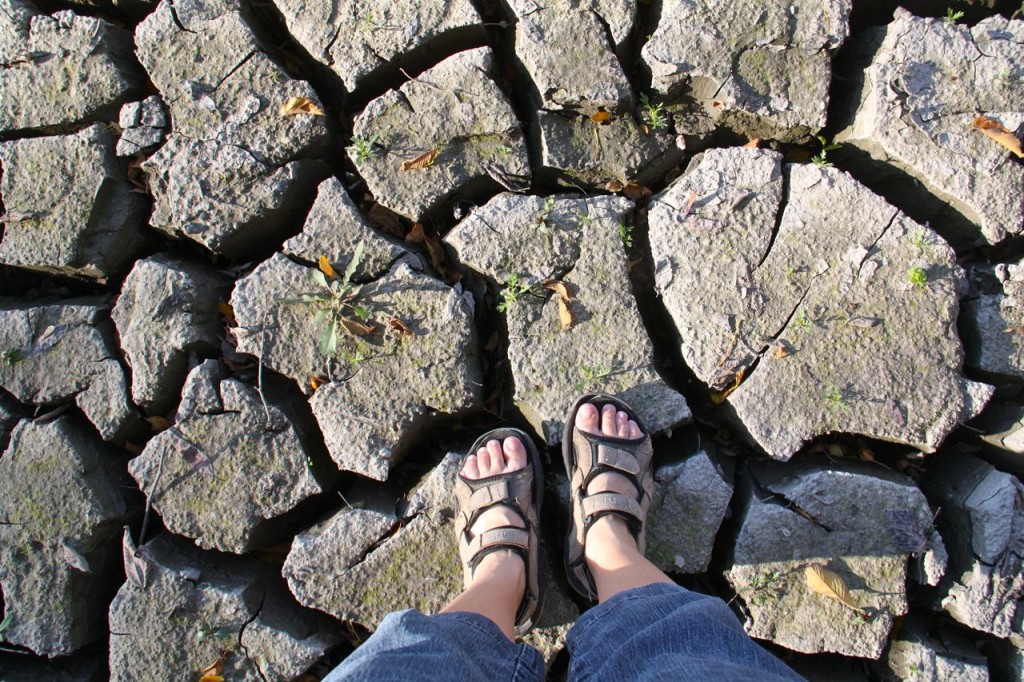 Note: Read all the way to the end of this post to find out how to enter to win free registration to Spectrum: A holistic visual journaling workshop.
Note: Read all the way to the end of this post to find out how to enter to win free registration to Spectrum: A holistic visual journaling workshop.
“All transitions are composed of an ending, a neutral zone and a new beginning” – William Bridges
In my last post, I talked about how the journey from Story A to Story B is almost always longer and more complex than we expect it to be. As the second diagram suggests, we must enter the labyrinth of transformation, release the old story on the journey in, sit quietly at the centre and wait patiently to receive what is there for us, and then make the return journey out of the labyrinth and into the new story that’s ready to emerge.
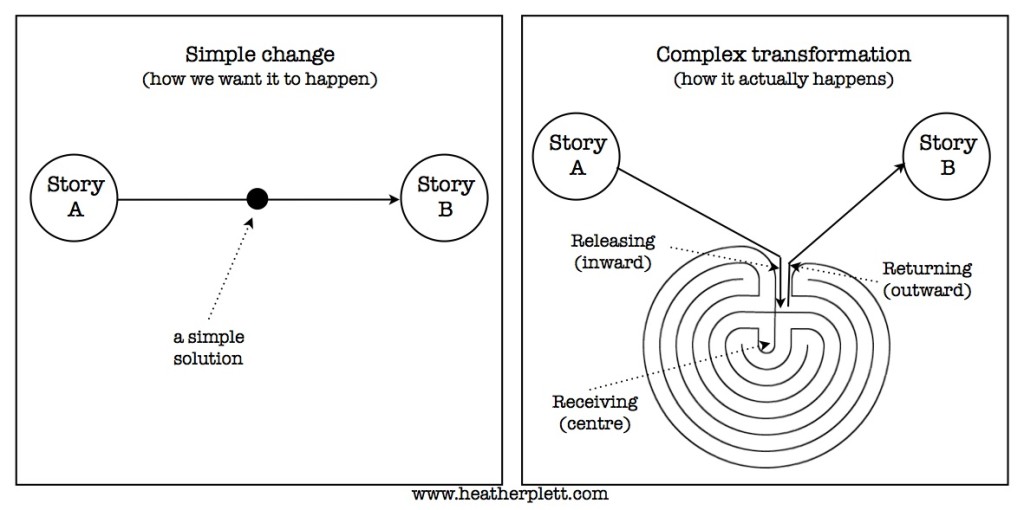 Several people have contacted me to say that the post resonated and that they find themselves in that in-between place. Some of them express their discomfort and want to know “what should I be doing in the in-between place?”
Several people have contacted me to say that the post resonated and that they find themselves in that in-between place. Some of them express their discomfort and want to know “what should I be doing in the in-between place?”
Here are some of my thoughts on how to live in the in-between place:
1. Let go of the mindset that you have to DO something. We are products of a culture that has convinced us that in order to have value, we must be active, we must produce things, and we must – at all costs – stay busy. I know it’s hard to break away from old patterns, but that mindset will not serve you well in this journey. New seeds do not grow on ground that is plowed every day. Nor can the land continue to be fruitful if it is not allowed to lie dormant through the winter. We need to learn a lesson from trees, release our fruit in the harvest season, release our leaves so that our trunks do not need to keep pumping sap through them and risk freezing, and simply lie dormant over the quiet season. Only then will we be ready to receive what is waiting for us at the centre. Only then can the new story begin to grow.
2. Be quiet. “To every thing there is a season, and a time to every purpose under the heaven… a time to keep silence, and a time to speak.” (Ecclesiastes 3) The in-between place is not a time for a lot of noise or conversation. It’s a more introverted time – a time to sit in your own silence and wait patiently for the wisdom to come. Turn off social media, cancel the parties, and just be quiet with yourself for awhile. The deepest wisdom in our hearts can’t be heard above the noise. If you can, go away for a silent retreat for a few days, or at least find time regularly to wander in the woods or in labyrinths.
3. Find the practices that sustain you and take you to a deeper place. This may be the time to bring in a new practice – dancing, yoga, meditation, Mandala Discovery, art journaling, walking, photography, etc. Find something that helps you get in touch with yourself and release the old stories.
4. Find an incubator where the new story can begin to grow in safety. It’s hard to believe in the new story that’s emerging if everyone you know is still stuck in old stories. To nurture your new story, find places where you feel safe trusting in what is possible. Find people (online or in person) who are also inviting in new stories and be intentional about supporting each other and growing new stories together.
5. Break away from the things that keep you stuck in the old story. This may mean you have to walk away from old jobs and unhealthy relationships. It may mean giving up some of your volunteer commitments that keep you too busy to walk the labyrinth. Be courageous in seeking what you know you need to get through this. Practice saying “no, this is not what I need right now”.
6. Be as honest as you need to be with the people around you. Be clear about your needs. You may need to tell your life partner “I need to be by myself for awhile. This is not about you – it’s about what I need for this transition I’m going through. I would appreciate your support.” It may mean you’ll need to tell your Mom “This is what is now true for me. It might make you uncomfortable, and it might not be true for you, but I’m asking you to respect my journey anyway.”
7. Allow yourself to grieve and to hospice the old story into its death. You’re letting go of something important. It’s a story that has sustained you for a long time. Don’t take that lightly. Allow yourself to properly grieve its loss. Don’t rush through the sadness or any of the other emotions that show up. Offer respect and gratitude to the old story for the role it played in your life. Give yourself permission to really feel this pain.
8. Be patient. The most difficult thing about this in-between place is that it doesn’t end as quickly as we want it to. Old stories need time to die. New stories need time to germinate. You won’t serve either story well if you rush from one to the next. You won’t serve yourself well if you don’t take the time that’s needed in between.
9. Remember that your journey is your own. No two journeys through this will look the same, so you’ll need to trust your own wisdom to get you through. You can seek advice from other people, read books about it, or take classes, but at the end of the day, nobody can know exactly what you need except for you. Trust that. Learn to listen for the voice of intuition.
10. Lean on a Higher Power. You’re not walking through this alone. God/dess wants to walk the journey with you, supporting you and holding you up when you get weary. Practice doing the things that help you get in touch with the God of your understanding – pray, meditate, be in nature, go to the synagogue, etc. Trust that something bigger than you wants this new story to emerge just like you do.
What’s your experience of the in-between place? Do you have any other points you’d like to add or any questions you’d like to ask? Add a comment to this post for your chance to win free registration to Spectrum: A holistic visual journaling workshop (where I’ll be teaching a workshop related to this post, on an art journal process inspired by labyrinths). Contest closes Friday, February 28 at 8:00 p.m. central.
Also, don’t forget that you have until Saturday morning to register for Mandala Discovery.
Note: All links to Spectrum are affiliate links, which means I’ll get a portion of the registration fees if you register through these links.
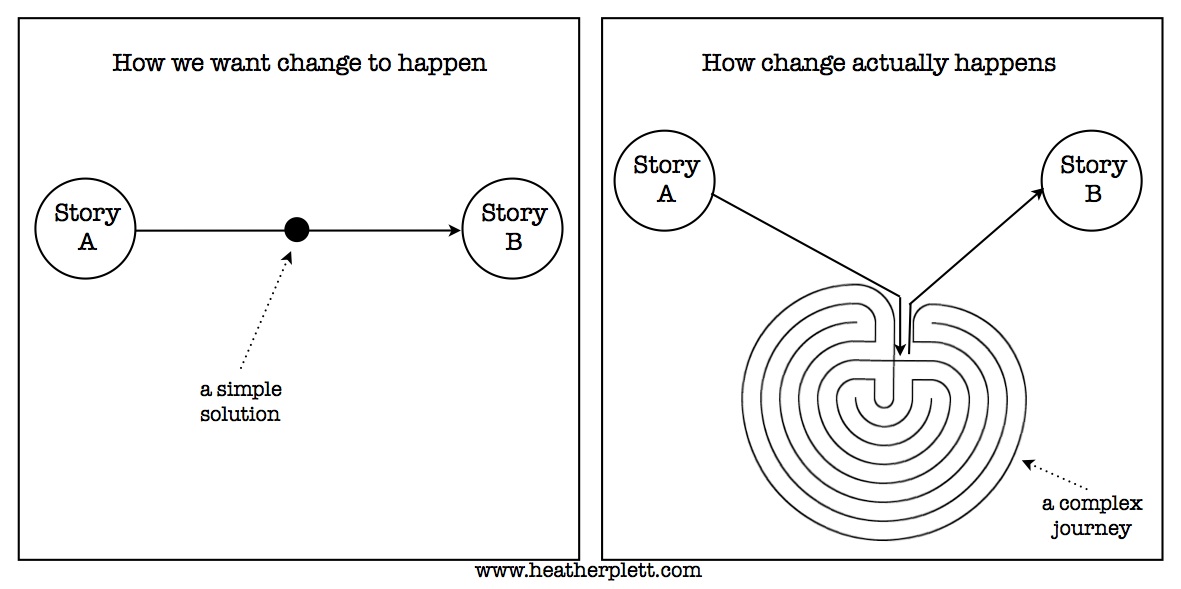
by Heather Plett | Feb 24, 2014 | change
“Do not be afraid of the empty place. It is the source we must return to if we are to be free of the stories and habits that entrap us.” – Charles Eisenstein
I’ve been having a lot of internal dialogues lately, and one of the conversations sounds a lot like this:
Me 1: “Mandala Discovery starts again on Saturday. Why aren’t you doing a better job of marketing it?”
Me 2: “I don’t know. I’m really struggling with marketing lately. Marketing language gets stuck in my throat.”
Me 1: “But you don’t have to be a traditional marketer to make this work. You just have to offer affiliate programs for past participants, buy Facebook ads, send out multiple reminders to your list, blah, blah, blah. Oh… And you have to be more clear about what they get for their investment. People don’t understand just how good Mandala Discovery is because your language is too vague.”
Me 2: “But… The trouble is, I can’t tell them exactly what they’ll get for their investment. Every journey through this will be different and they’ll each find what they need on the journey. I can’t tell them what need will be filled because I don’t know their unique needs.”
Me 1: “How do you think you’ll ever be a successful entrepreneur if you don’t learn to speak in clear marketing lingo? You’ve worked in PR for a long time – surely you know how to tell the story that will sell the product. ‘You want to get to Story B and you’re stuck at Story A? Buy this simple product and you’ll have guaranteed success.’”
Me 2: “That really doesn’t work for me. Nothing I sell fits into the ‘simple product’ category. I don’t offer simplicity. I offer complexity. I invite people into the ‘empty place’ (that Charles Eisenstein talks about in that quote at the top of this page). You can’t put that empty place on a sales page.”
And so it goes, on and on, with Me 1 trying to be more financially successful and Me 2 trying to be more authentic.
Me 2 usually wins, but Me 1 is stuck in some old stories about worthiness and conventional wisdom, and so the dialogue continues.
Last week, I had a series of a-ha moments that have helped me clarify my work even further. First of all, I was working with the leadership team of a local organization that was going through a major transition. When I did individual coaching with each of the people involved, I realized that the stories they were each living in were not in alignment with the direction the organization was heading. In the group conversation I hosted, these stories started coming out, and they realized that the true story that was emerging was very different from what they’d thought was needed. Embracing this true story meant that they would have to release something that was very important for all of them, and possibly even close the doors of the business. This came with a lot of grief that they will have to work through in the coming months. I was reminded, as I held the container for their stories to emerge, that part of my work is to help people and organizations navigate this difficult journey of grief and change in an authentic way.
The work I deeply believe in is not a simple step from Story A to Story B – it’s the releasing of Story A, living in the complexity and grief of that loss, and then being in the empty place where Story B can begin to emerge.
A similar thing happened in my coaching work recently. A client had hired me for three sessions, and in the first session a few months ago, she was trying to decide what her true work was and whether she should leave her job or change jobs to step into something new that felt more purposeful. Finally, however, in the third session, she admitted what she really wanted. “I don’t really want to have a purpose right now. I just want to BE for awhile. I don’t want to DO. I just want to give myself permission to SIT.”
And so, instead of giving her ten easy steps on how to move from story A to story B, we worked on what that empty place would look like and how she could give herself permission to be in it, spending time in play and stillness. She’s now got plans to go away on a personal retreat and to spend time creating a quilt that has no planned outcome, design, or recipient.
Again and again, as I do this work, I hear the longing in people’s hearts for real transformation. In the longing is the assumption (or desperate hope, or outside pressure of family and friends) that they can find a simple fix that will help them move from Story A to Story B. That’s what the marketers have been telling us for years, and so that’s what we want to believe. “Buy this car and you’ll finally feel good about yourself. Use this skin cream and you’ll never age. Take this course and your confidence will grow. Sign up for these coaching sessions and you’ll magically be ready to step into your bigness.”
But when I go deeper with my clients, they recognize that their authentic journeys have nothing to do with the easy steps the marketers want to sell them. Real transformation doesn’t work that way. Real transformation is much more complex and nuanced, and doesn’t fit into bullet points.
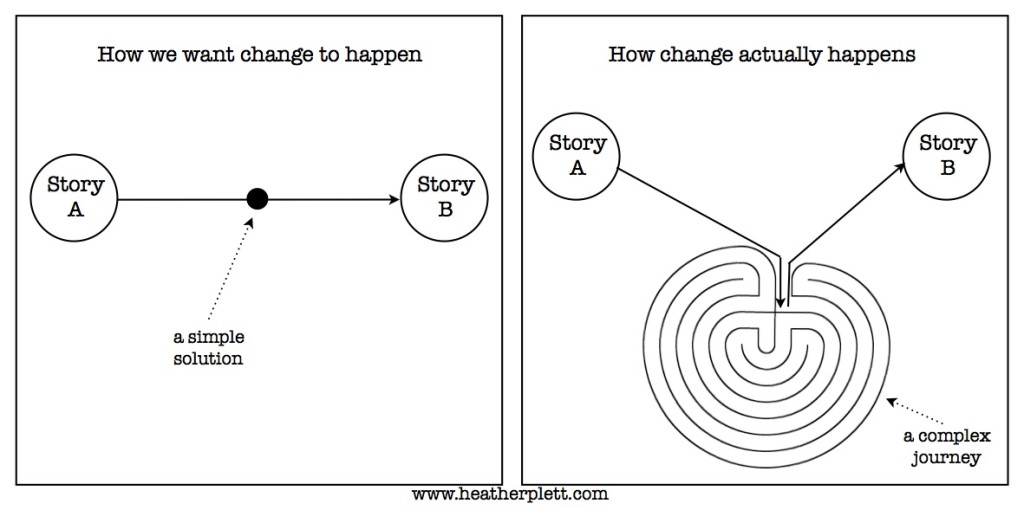
As the illustration suggests, we all want the bullet points that will help us take a direct path from Story A to Story B. But the truth is, the bullet points short circuit the change and Story B doesn’t really have an opportunity to grow out of it.
If we really want Story B to emerge, we have to be willing to let go of Story A, take the winding journey through the labyrinth, and wait for Story B to emerge naturally.
There are three stages to the labyrinth journey. When we journey inward, we release. When we cross the threshold and stand at the centre, we receive. When we journey outward, we return. But we don’t return to Story A. We take what we have received at the centre, we allow ourselves to be transformed, and we follow where the path is leading to Story B.
It’s easy to sell the bullet point, but it’s much harder to sell the labyrinth.
Nobody wants to step into complexity and messiness. Nobody wants to feel lost and confused.
We want short cuts through the grief and emptiness that comes when we let go of Story A, and so we go shopping, we overeat, we sign up for courses, and we try to bury our fear in staying busy. Instead of sitting still at the centre of the labyrinth, we rush to find our new purpose.
Instead of releasing and stepping into trust, we hang on tightly to stories that no longer serve us.
Instead of risking the pain of growth, we try to fool ourselves with the ten easy steps to a better life.
In The More Beautiful World Our Hearts Know Is Possible, Charles Eisenstein talks about The Story of Separation that the world has been living in. That’s a story that keeps us locked in a financial economy that demands growth and the pillaging of the earth for the resources that feed that growth. It’s a story that has us living as separate, self-sufficient individuals instead of in community. It’s a story that requires a greater and greater investment in military actions that help us protect our resources and our self-sufficiency.
The new story that the world is longing for is a Story of Connection. It’s a story that brings us back to a healthy relationship with each other and the earth. It’s a story of trust and compassion, community and spirituality.
As the diagram shows above, we won’t get to the Story of Connection until we are ready to release the Story of Separation, step into the centre of the labyrinth, and receive the new thing that wants to be born in each of us.
I want to be part of that Story of Connection, and that is why I will never sell you what you don’t need, or try to convince you that anything I offer will provide you with an easy solution.
I won’t get rich doing this work, but that’s not one of my values anyway. Getting rich would simply help me hang onto that Story of Separation.
What I would much rather do is invite you to let go of the stories that no longer serve you and step into the labyrinth with me.
I can’t promise you that it will be easy or that the path will be smooth. From personal experience, I know that transformation is rarely easy or smooth. There will be grief, you will have to step into the shadows, and there will be moments when you’ll feel completely lost. Some days, in fact, you will probably regret that you accepted my invitation to step onto this journey.
In the end, though, it will be worth it. The new story will be more beautiful than anything you’ve had to release. You will gradually find your way into your authentic heart, and that is the most beautiful place that you can live. Along the journey you will find other pilgrims who are also finding their way through the grief and shadows, and you will discover that being in community is much better than living a self-sufficient life.
If this is a place you’d like to go, then I invite you to start with Mandala Discovery. You’ll receive 30 prompts that will guide you through a labyrinthian journey into your own heart.
If you want to go even deeper, consider one-on-one coaching and/or a journey through Lead with Your Wild Heart.
p.s. In my desire to live in the gift economy, I look for ways to support people that doesn’t involve financial transactions. If you are interested in any of my programs and do not have sufficient financial resources, please contact me to see if we can work something else out.
by Heather Plett | Feb 17, 2014 | Uncategorized
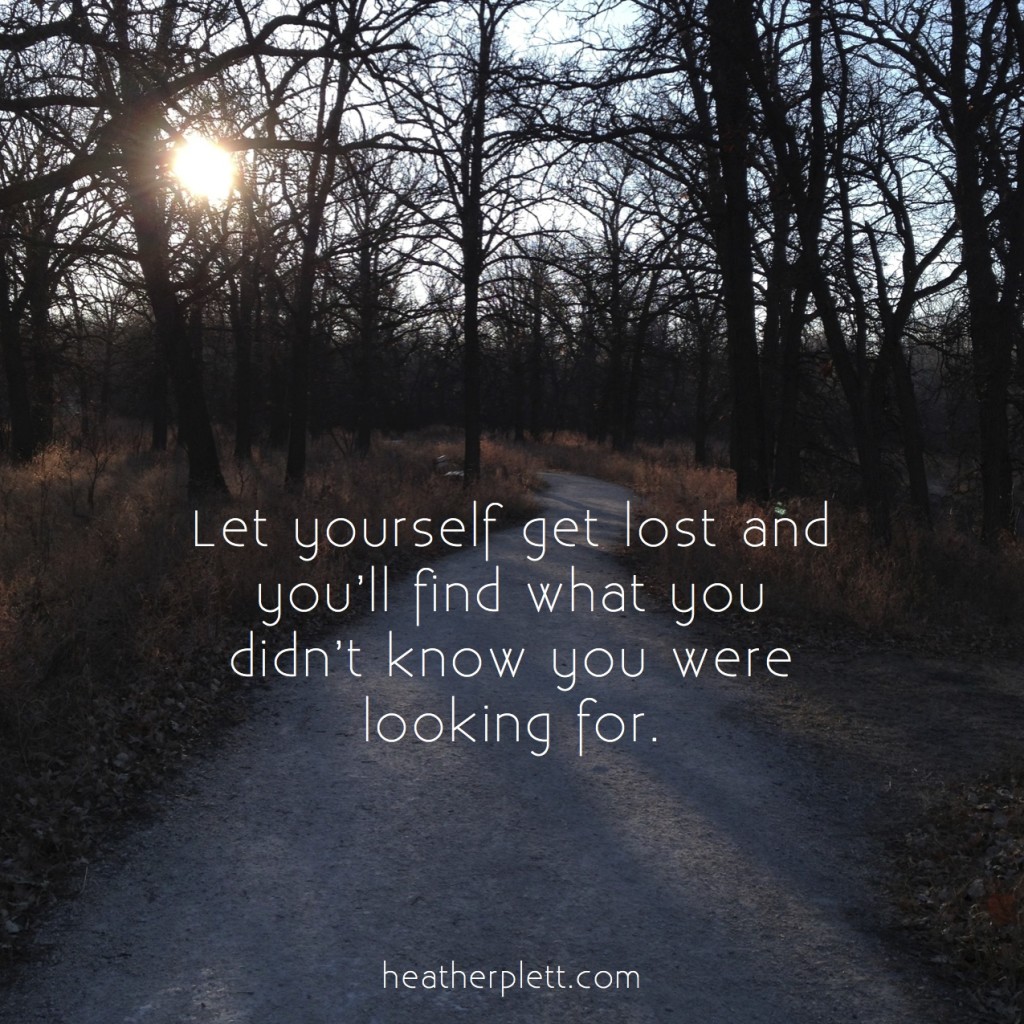 There’s a meme floating around on Facebook. A six word memoir. Write your life in six words. Here’s what I wrote…
There’s a meme floating around on Facebook. A six word memoir. Write your life in six words. Here’s what I wrote…
Lost and found. Again and again.
This is my life.
Walking the path I think is mine,
Until it doesn’t feel like mine anymore.
Finding myself profoundly lost.
Floundering in the dark until light peeks through the shadows.
Finding my way back to myself.
Finding ease for awhile, and then…
Entering another dark place.
Lost. Again.
Sometimes by my own choosing,
And sometimes guided by circumstances.
At first it felt like I was doing something wrong,
Like I just wasn’t as good as everyone else at finding direction.
Like I was doomed to wander in the world,
Never finding the kind of clarity others seem to have.
Then I learned that this is the right way.
Lost and found. Again and again.
Each time, going deeper.
Each time, learning to understand the darkness more.
Each time, finding new truths about myself.
Finding those secrets I wouldn’t know if I were always found.
The lost place is the place where truth whispers.
The place where wisdom shines through the dark.
The place where I learn to let go.
The place where I learn to trust.
The lost place is where I finally get found.
Where I finally remove the mask.
Where I finally release what no longer serves.
Where I finally give in to what wants to be born.
The lost place is my salvation.
My surrender.
My birth.
My letting go so that I can be found.
Lost and found. Again and again.
Note: Are you finding yourself lost again? A journey through Pathfinder might help.
by Heather Plett | Feb 15, 2014 | writing
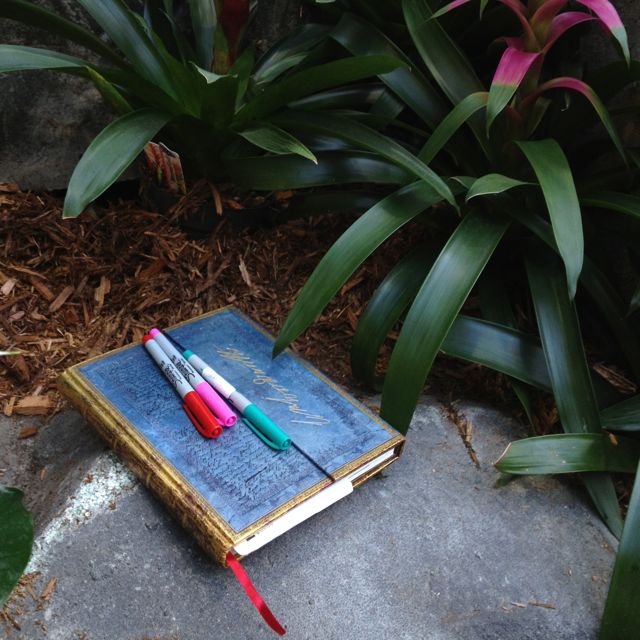 Yesterday I hosted an Openhearted Writing Circle. It was beautiful. When people dare to come together to explore and share their raw and courageous stories, magic happens.
Yesterday I hosted an Openhearted Writing Circle. It was beautiful. When people dare to come together to explore and share their raw and courageous stories, magic happens.
Before they started to write, I gave them these simple suggestions. I give them to you, too, in case you want to be an openhearted writer.
- Be in love. Write from a deep source of love that wants to flow through you. You are not writing for a critic, you are writing for love. Dare to be in that love.
- Be courageous. Dare to dive deeper into your own truth than you ever have before. Dare to say those things that make you tremble.
- Be honest. There is no point in watered-down truth. If you are lost in a dangerous sea of sadness that threatens to drown you, and you say simply “I’m a little sad”, you’re not telling the whole truth.
- Be authentic. Nobody wants Hemingway’s stories coming out of your pen. Only YOUR stories can come out of your pen, and your stories are as unique and valuable as Hemingway’s, even if they’re never published and are meant simply for your own healing.
- Be messy. You don’t have to get it right the first time. Or even the second. Let yourself get messy and spill all that you have onto a page. There will be time to polish later, but to start with, get it all out there without editing what wants to flow. The most beautiful gems show up when you make the least attempt to edit yourself.
- Be kind to yourself. Silence the inner critic and simply let yourself write. You are not seeking perfection, you are simply seeking a gateway into your truth.
- Be passionate. Dare to show the fullness of your emotion – your love, hate, fear, strength, anger, etc. – on the page. Dare to shout “YES!” to the world through your writing. Dare to live out loud.
- Be generous. Give it ALL to the page (and to your reader), not just a token. If there’s wisdom that wants to flow out of you right now, don’t save it for another day – let it flow. Be intentional about living in the gift economy, where we serve each other instead of seeking a “return on every investment”. You have gained wisdom in your years on the earth and others need it, so share it.
- Be patient. “If good ideas do not come at once, or for a long time, do not be troubled at all. Wait for them. Put down the little ideas however insignificant they are. But do not feel, any more, guilty about idleness and solitude.” – Brenda Ueland
- Be trusting. There are stories in you that want to be told – trust the muse to help you tell them. Trust yourself to have the right words and the right creativity.
- Be shameless. The greatest barrier for people telling truthful, raw stories is often the shame that we feel about that story. “What will people think if they know this about me?” But that keeps us from really connecting and helping other people through our stories.
by Heather Plett | Feb 10, 2014 | Creativity, growth, mandala, Uncategorized
Today, the doors open once again for Mandala Discovery: 30 Days of Mandala Journaling. Sign up now and you’ll receive a prompt every day for 30 days during the month of March.
This course is changing people’s lives. Nearly 200 people have been through the course since it opened in September 2013, and I have heard remarkable stories of how it has impacted people in positive ways. (Some of their testimonials are on the sales page.)
In honour of registration opening once again, below is a sample prompt. In case you’re curious, but do not quite understand what the course is all about, this will give you a sense of what you’d receive every day.
Each day is based on a different theme related to personal growth. This sample prompt is based on the them of “roots”.
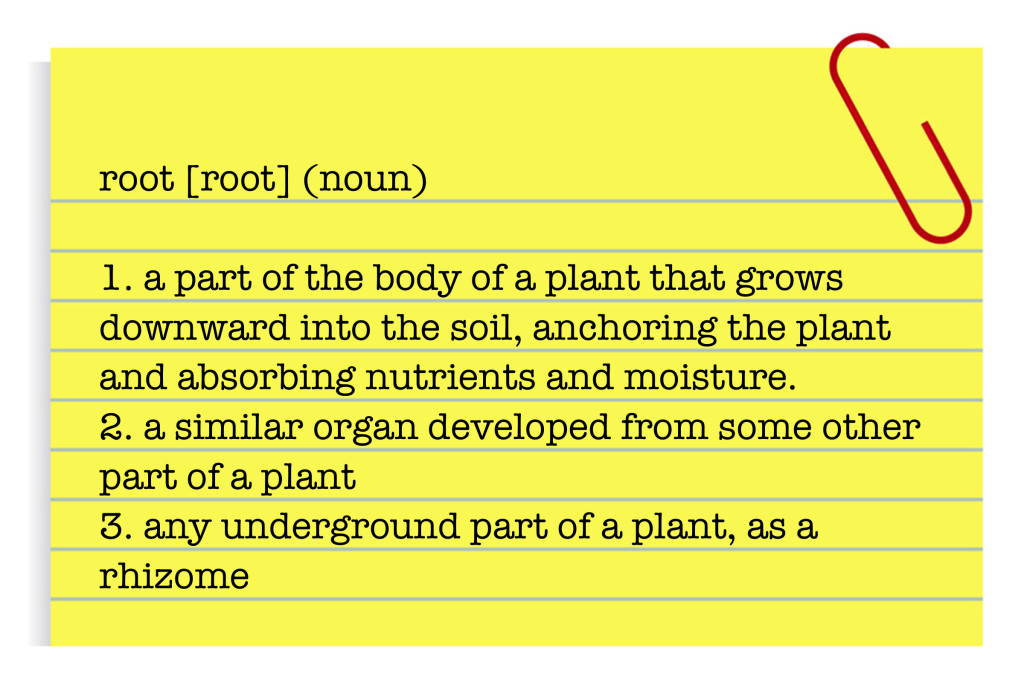
Where Your Roots Grow
A couple of years ago, I had the privilege of participating in a healing circle for people who’d been impacted by residential schools in our country. This is a tragic chapter of Canada’s history in which Aboriginal children were taken from their families and placed in boarding schools where they were denied their own cultural practices and language, and many were physically and emotionally abused.
A few of the people in the circle had been students at residential schools, but more of them had been raised by parents who were forced to attend residential schools. And then there were those of us who didn’t have residential schools in our blood line, but knew that we were impacted nonetheless, because our community members were impacted and because we were raised as white Canadians with a colonial history. Some of our ancestors undoubtedly shared in the guilt of this injustice.
As we listened to the stories shared around the circle, it was clear that all of us carried both the wounds and the wounding of our ancestors. It was especially apparent in those who’d been raised with parents who’d been in residential schools. Some of them spoke of alcoholism, family abuse, cultural neglect, and other stories that clearly left deep wounds in their collective psyche.
Whatever our roots are – whether we were raised in a lineage of oppressed or oppressors, religious or agnostic, poverty or wealth – we all carry the stories of our ancestors with us.
Our roots reach much deeper into the soil of our family’s past than we ever fully understand. We are impacted by the history that happened in our bloodline long before we were conceived and born into this world.
Bethany Webster talks about the importance of healing the mother wound. “The mother wound is the pain of being a woman passed down through generations of women in patriarchal cultures. And it includes the dysfunctional coping mechanisms that are used to process that pain.” The mother wound manifests itself in our lives as shame, comparison, the feeling that we need to stay small, allowing ourselves to be mistreated by others, and self-sabotage. If we do not heal it, she says, we continue to pass this wound down through the generations.
We must also consider the ways in which patriarchy has men. As Richard Rohr says, “After 20 years of working with men on retreats and rites of passage, in spiritual direction, and even in prison, it has sadly become clear to me how trapped the typical Western male feels. He is trapped inside, with almost no inner universe of deep meaning to heal him or guide him.” Men have to come to terms with their own wounds and often have little support to find healing for them.
These stories that we carry from our past – that we are not worthy, that we need to stay small, that we are not allowed to show emotion, that our cultures don’t have as much value as that of our colonizers, or that we are not allowed to do anything that goes against our religion for fear of hell – they are the soil in which our roots grow. If that soil is not fertile and nurturing, our growth is impaired and we never reach our full potential.
Imagine, though, that through an alchemical process, these stories can be healed and transformed and can become the fertile soil we need for healthy growth. Imagine that they can provide rich fertilizer to feed our roots and make our branches grow and our fruit to be plump and sweet.
We can transform these stories. They do not need to keep us small. They do not need to hold us back from what we can become.
Through much inner work – whether that looks like therapy, journaling, dance, meditation, mandala-making, or any other form of self-discovery and healing – we can cultivate those stories and stir them like a compost heap until they become the richest of fertilizer. This is not easy work, and it is not short-term work, but it is necessary work. The world needs us to heal and the world needs us to grow strong and true.
After reading the article by Bethany Webster, about the need to heal the Mother Wound, I wrote a letter to my mom. She died last year, so she won’t read it on this earth, but I still felt like there were some things I needed to say to her. I acknowledged the way that she had been wounded (by losing her mother when she was six, for example) and forgave her for the way that those wounds were passed on to me. I thanked her for the love she poured on me and my siblings despite the deep wounds she carried. Writing the letter felt significant – like I had begun to heal something for both myself and for her. There is more work to do, but every step toward healing is a step in the right direction.
Consider what Charles Eisenstein says about how our healing can contribute to the world’s healing (in “The More Beautiful World Our Hearts Know is Possible”):
“When I see how my friend R. has, in the face of near-impossible odds, so profoundly healed from being abused as a child, I think, ‘If she can heal, it means that millions like her can too; and her healing smooths the path for them.’
“Sometimes I take it even a step further. One time at a men’s retreat one of the participants showed us burn scars on his penis, the result of cigarette burns administered by a foster parent when he was five years old to punish him. The man was going through a powerful process of release and forgiveness. In a flash, I perceived that his reason for being here on Earth was to receive and heal from this wound, as an act of world-changing service to us all. I said to him, ‘J., if you accomplish nothing else this lifetime but to heal from this, you will have done the world a great service.’ The truth of that was palpable to all present.”
Eisenstein goes on to talk about scientific research into “morphic resonance” in nature – the concept that once something happens somewhere, it induces the same thing to happen elsewhere. Some substances, for example, are reliably liquid for many years until suddenly, around the world, they begin to crystallize. It is not clear why it happens, when these substance are not in contact with each other or exposed to the same environment, but it seems that a change to one begins to result in changes to others. In the same way, he says, the healing of one person can lead to the healing of others, even if those people never meet.
Transforming your stories into rich soil so that you can grow strong is necessary not only for you, but for the world.
Your Roots Mandala
Imagine you are a tree, firmly rooted in the stories of your past. Some of these stories are conscious for you (memories from childhood) and some are less conscious but you are impacted by them nonetheless.
Begin by drawing a large circle. In the centre of the circle, draw a small circle that represents the trunk of a tree. Reaching out from that trunk into the fertile soil around it, draw the roots of that tree. (Imagine you are looking down on the tree from above and can only see that part of the tree that is underground, not the branches or leaves.)
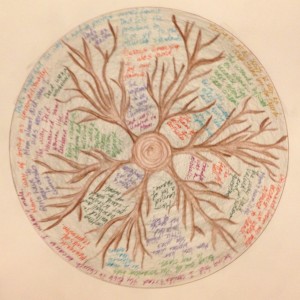 Between the roots, write down stories that are part of your past. Start with the stories that you know have impacted you and your growth in both positive and negative ways. Your religious upbringing, your father’s temper, your mother’s insecurity, your grandmother’s way of making you feel special, your birth order, your childhood abuse, etc. Do not censor yourself – if a story shows up, there’s a good chance it had an impact on you whether or not you recognize it. (There is no right or wrong way to do this – your stories are your own and you know what matters to you.)
Between the roots, write down stories that are part of your past. Start with the stories that you know have impacted you and your growth in both positive and negative ways. Your religious upbringing, your father’s temper, your mother’s insecurity, your grandmother’s way of making you feel special, your birth order, your childhood abuse, etc. Do not censor yourself – if a story shows up, there’s a good chance it had an impact on you whether or not you recognize it. (There is no right or wrong way to do this – your stories are your own and you know what matters to you.)
Reach further back. What are the stories that impacted your lineage before you were born? Your family’s displacement from the country they called home, your grandmother’s abusive marriage, your ancestors’ connection to colonialism or oppression, your grandfather’s death when your mother was small.
Write them all down. Some of them may bring up pain, and some may bring up positive memories. Some may have a clear impact on your life, and some you may not fully understand until a much later date. They are all part of your narrative and they are all part of the soil in which your roots dig for nourishment.
With a black pencil crayon, shade over the stories you have written, imagining that all of them are now becoming part of the compost that helps you grow. Whether good or bad, those stories are your soil.
Note: This exercise may bring up a lot of mixed emotions for you. It may feel like a little bit of healing, or it may feel like you’ve opened a wound that is still raw. That’s all part of the healing process. Sit with whatever comes up and do not try to suppress it. If you need to, do some further journaling to explore what came up, or find someone you trust that you can talk to about this.
You can find a downloadable pdf of this lesson here.
Did you find this useful? Consider signing up for the March 2014 offering of Mandala Discovery: 30 Days of Mandala Journaling. You’ll get 30 more like this.
 Note: Read all the way to the end of this post to find out how to enter to win free registration to Spectrum: A holistic visual journaling workshop.
Note: Read all the way to the end of this post to find out how to enter to win free registration to Spectrum: A holistic visual journaling workshop. Several people have contacted me to say that the post resonated and that they find themselves in that in-between place. Some of them express their discomfort and want to know “what should I be doing in the in-between place?”
Several people have contacted me to say that the post resonated and that they find themselves in that in-between place. Some of them express their discomfort and want to know “what should I be doing in the in-between place?”





 Between the roots, write down stories that are part of your past. Start with the stories that you know have impacted you and your growth in both positive and negative ways. Your religious upbringing, your father’s temper, your mother’s insecurity, your grandmother’s way of making you feel special, your birth order, your childhood abuse, etc. Do not censor yourself – if a story shows up, there’s a good chance it had an impact on you whether or not you recognize it. (There is no right or wrong way to do this – your stories are your own and you know what matters to you.)
Between the roots, write down stories that are part of your past. Start with the stories that you know have impacted you and your growth in both positive and negative ways. Your religious upbringing, your father’s temper, your mother’s insecurity, your grandmother’s way of making you feel special, your birth order, your childhood abuse, etc. Do not censor yourself – if a story shows up, there’s a good chance it had an impact on you whether or not you recognize it. (There is no right or wrong way to do this – your stories are your own and you know what matters to you.)